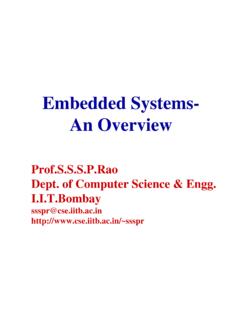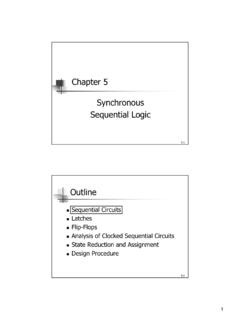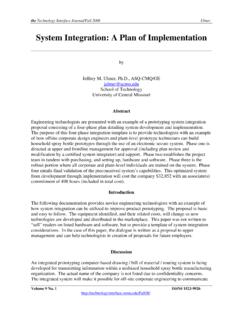Transcription of A Distributed File System - cse.iitb.ac.in
1 A Distributed File System (that has the name spaces and semantics that resemble those of the Windows File System )Design Overview DocumentSubmitted by:Surabhi Ghaisas (07305005)Rakhi Agrawal (07305024)Election Reddy (07305054)Mugdha Bapat (07305916)Mahendra Chavan(08305043)Mathew Kuriakose (08305062)Sameera Deshpande (08405003)Issues in implementation of Distributed File vs stateless file System sharing semantics server and and granularity Stateful vs Stateless File SystemStateful file systemIn stateful file System , the state of the file processing activity is remembered in stateful file System , Client opens the file.
2 Server fetches information about the file from its disk. It loads that file in its memory A connection identifier unique to the client and the open file is given to the client. This identifier is used by client to perform subsequent accesses to file until the session ends. Its server's responsibility to reclaim the main memory used by clients that are no longer : It is simple. Fewer disk accesses are needed at server side. Server knows if the file was opened for sequential access, and hence can read ahead the next blocks. It reduces the network traffic as client need not send state information with every call to : When the client crashes, the file processing activity should be abandoned, and the file state should have to be restored to its previous consistent state, so that the client can restart its file processing activity.
3 The resources allocated to aborted file processing should have to be released. When the server crashes, the state information stored in file server metadata is lost, hence the file processing activity should be terminated. Thus client knows about server file systemIn stateless file System , the state information about file accessing activity is not maintained by the server. Instead, client maintains state information about the file processing activity. The information about the desired activity is provided to the server when the service is requested through file System stateless file service, Client performs System call which contains information about which file to be accessed, which operation to be performed, which part of the file to be accessed, etc.
4 At this call, server opens the desired file, and performs the action on the specified part of the file. When client receives the response from server, it assumes that the operation requested has been completed successfully. If the file server crashes, timeouts and retransmission occurs at client site. When server site recovers, it answers to the retransmitted request of client. Hence, client is unaware of server : Stateless server is more robust than stateful file server, hence they provide fault tolerance. Lost connections can't leave a file in an invalid state. Rebooting the server does not lose state information.
5 Rebooting the client does not confuse a stateless : As the server doesn't maintain any state information about file processing activity, it cannot detect and discard duplicate requests from client. To ensure consistency of files, the requests made by clients must be idempotent. The stateless file server incurs performance penalty due to: The file server opens the file at every file operation. When client performs write operation, the changes are needed to be reflected in disk copy of the file. Stateless file server cannot employ file caching or disk windows, stateful file System is used. We plan to implement stateful file System .
6 The state of the file consists of: id (information about file can be retrieved from metadata of file System ) of next record to be where the file for which the file is being accessedFile Sharing SemanticsThere are different types of file sharing semantics: Unix Semantics Every operation on a file is instantly visible to all processes. Session Semantics No changes are visible to other processes until the file is closed. Immutable files A file once created cannot be changed. Such a file cannot be opened for modification, it can be opened only for reading. In case of immutable files cache coherency becomes easier to implement.
7 Atomic Transaction To access a file a process executes a begin transaction to notify that all futher operations will be executed indivisibly. After completion it executes an end plan to use session semantics for our Distributed file System . In this case, as mentioned above, changes to a file are not visible until the file is closed. So we need to limit the concurrent access to a file by different processes in the System by use of a Distributed locking Server and PermissionsThere are two strategies which we can adopt for implementing the name space server: alone (Centralized) based ( Distributed ).
8 We are planning to go for domain based namespace server. In our case it would be a two level model. At the root level would be the RootDNS. Root DNS would be maintaining the list of all the files/folders created immediately under /. For each of the files/folders in this list, it would keep the addresses of the respective DomainDNSs on which they were created. Please note that RootDNS will not store the links and permissions for any of the files/folders. Below the root level would be a number of DomainDNS servers. Every DomainDNS would serve for a number of nodes. Each DomainDNS server would maintain a virtual tree of all files/folders created by the nodes in its domain under /.
9 We would be providing read, write, modify, read&execute, fullcontrol permissions for files and read, write, modify, read&execute, fullcontrol, listfoldercontents for folders. Permissions for folders and files would be maintained along with the links in the DomainDNS namespaces. Whenever a user tries to access a file/folder, permissions will be checked at DomainDNS level and will be given access to actual file/folder only if he/she has the requested permission to shown in the Figure 1 nodes will be divided into domains say A,B,C,..Each domain will have one DomainDNS.
10 There will be one RootDNS. DomainDNS_A will maintain the information about folders (level 1) and files(level 1) created by nodes in DomainA. DomainDNS_A also maintains information about folders and files created under its level 1 folders by any node in any 1 Few scenariosIn the following scenarios, we assume that each node has one user with name same as the node C1 requests DomainDNS_A to create a folder /A DFS folder would be created on C1 and DomainDNS_A would create a folder entry for folder /A in its virtual tree along with a link to the folder and permissions bitmap (Full Control in this case) in its virtual would pass on the folder name /A to would insert (/A,DomainDNS_A)



















